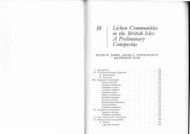You also want an ePaper? Increase the reach of your titles
YUMPU automatically turns print PDFs into web optimized ePapers that Google loves.
66 Thallus with Trentepohlia algae, when scratched<br />
or scraped <strong>of</strong>ten orange to gold brown (in<br />
problem cases check alternatives!) . 67<br />
66* Thallus not with Trentepohlia, commonly with<br />
true green algae 80<br />
67 Sp. 2-celled . 68<br />
67* Sp. with more than 2 cells . 71<br />
68 Paraph. reticulate bound. Exc. Reduced, very<br />
thin to lacking. Ap. without margin. Hym. I+<br />
(yellow)orange, dirty gray-blue or blue. Asci<br />
thickened above Arthonia<br />
68* Paraph. simple to sparsely forked. Exc. Clearly<br />
developed. Ap. with or without margin. Hym. I-<br />
or I+ blue . 69<br />
69 Ap. whitish to orange, with concave to flat disks.<br />
Hyp. (Exc. ±) colorless. Spores fusiform to<br />
ellipsoidal. Thallus thin, light gray to green,<br />
film-like to scruffy, on bark and mosses<br />
Dimerella<br />
69* Ap. dark. Hyp and exc. dark or light 70<br />
70 Sp. at first colorless then brown, cells sometimes<br />
unequal in size. Ap. rounded to streaked, black.<br />
Thallus indefinite. Asci I- Melaspilea<br />
70* Sp. remaining colorless, cells equal in size. Ap.<br />
rounded, black or dark red-brown. Asci I+ blue<br />
at least above. GS Catillaria<br />
71 Ap. Not black . 72<br />
71* Ap. black, however sometimes pruinose. . 74<br />
72 Sp. to 16 or more per ascus, long fusiform to<br />
almost thread-like, -5 µm wide. Ap. brown-red<br />
to orange-brown, -0.6 mm, with concave disk.<br />
Asci not thickened at the apex. Epihym. Brown.<br />
Hyp. colorless. On bark. Pachyphiale<br />
72* Sp. 8 per ascus 73<br />
73 Ap. bordered, with clearly developed exc., disk<br />
<strong>of</strong>ten concave or deeply sunken. Asci usually<br />
very lax, cylindric-clavate. Sp. long fusiform to<br />
ellipsoidal. Ap. yellowish, rose, red, or (dark)<br />
brown. On bark, soil, rock, or plant residue<br />
GS Gyalecta<br />
73* Ap. without margin, exc. reduced. Asci broad,<br />
wall strongly thickened above . Arthonia<br />
74 Sp. needle-form, 50-80 x 1.5-2.5 µm,<br />
multicellular, disintegrating in short segments.<br />
Ap. black. Thallus whitish, almost exclusively<br />
on oak bark GS Lecanactis: Bactrospora<br />
74* Sp. shorter, not disintegrating into small pieces,<br />
usually fusiform . 75<br />
75 Paraph. simple or with scattered branches, in<br />
other parts occasionally bound. Sp. 4-celled,<br />
with perispore, 12-28 x 6-9 µm. Asci thin<br />
walled, with thick tholus, not fissitunicate, wall<br />
I+ blue. Exc./hyp. dark brown. Ap. black (redbrown<br />
when fresh), <strong>of</strong>ten with split margin. On<br />
calcareous rock . Sagiolechia<br />
75* Paraph. branched and reticulate bound. Asci<br />
thick walled, fissitunicate . 76<br />
76 With strongly developed dark receptacle/exc.,<br />
without thalloid margin. 77<br />
76* Receptacle/exc. reduced, with or without thalloid<br />
margin . 79<br />
77 Ap. almost perithecia-like, with narrow<br />
punctiform disks. Dark exc. only developed in<br />
places, hyp. light. Thallus (dark) brown, with<br />
lighter soralia, commonly with a dark prothallus.<br />
. Enterographa zonata<br />
77* Ap. with wide open disks. Dark exc. even the<br />
underside developed, producing a cup-like<br />
receptacle . 78<br />
78 Ap. <strong>of</strong>ten not uniformly rounded, disks<br />
sometimes with an umbo or groves. Receptacle<br />
black, underside <strong>of</strong>ten strongly developed. On<br />
rock . Opegrapha<br />
78* Ap. usually uniformly rounded, <strong>of</strong>ten pruinose,<br />
with smooth disk, usually with proper margin.<br />
Receptacle black-brown. On rock and bark .<br />
Lecanactis<br />
79 Ap. with a finally inconspicuous, black, rarely<br />
pruinose thalloid margin differentiated from the<br />
thallus. The fresh thallus slightly reddish, the old<br />
(in the herbarium) whitish to cream colored. Sp.<br />
4-celled, fusiform, 25-42 x 2.5-4 µm. Hyp. dark.<br />
On bark . Schismatomma abietinum<br />
79* Ap. without thalloid margin, uniformly to<br />
irregularly rounded or short lobed, without<br />
margin, brown to black, sometimes thickly white<br />
pruinose. Sp. -25 µm long . Arthonia<br />
80 Ap. margin separated from an at first narrow<br />
central star-like ap. opening in 4-8 triangular<br />
lobes. Disk concave, rose, rose-brown, or<br />
yellowish. Ap. extensively up to half sunken in<br />
calcareous rock. Sp. 4-celled. Thallus indefinite.<br />
With Scytonema algae Petractis clausa<br />
80* Ap. margin not set <strong>of</strong>f star-like from the center.<br />
Not with Scytonema algae, but with green algae<br />
81<br />
81 Ap. disk yellow, orange, or brown-orange, K+<br />
immediately deep red. Sp. 2-celled. . Caloplaca<br />
81* If ap. disk yellow to orange colored, then not<br />
immediately K+ deep red . 82<br />
82 Ap. margin with algae (in section), externally<br />
almost always colored as the thallus 83<br />
82* Ap. margin without algae, generally colored like<br />
the disk, or without a margin . 86<br />
83 Ap. disk yellow, dirty yellow, or orange, K- to<br />
gradually slightly reddish. Sp. 2-celled. Thallus<br />
yellow or gray . Candelariella<br />
83* Ap. disk not yellow to orange . 84<br />
84 Sp. sometimes 30 µm long, fusiform to needlelike,<br />
with (1)3-7 cross-septa. Ap. red, K+ dark<br />
red or blue, or rarely the ap. brown, nonpruinose,<br />
concave to moderately convex. Hyp. ±<br />
colorless . GS Haematomma<br />
84* Sp. shorter, 2-4 celled. Ap. not red 85<br />
85 On decayed wood, peat, raw humus, or mosses,<br />
very rare on acid silicate rock. Ap. rose or rose<br />
beige, at first with whitish margin, 1-3 mm<br />
Icmadophila (91)<br />
53





